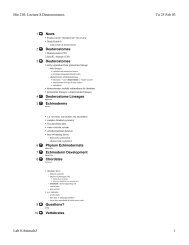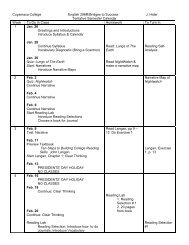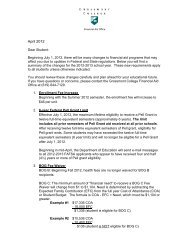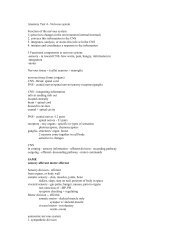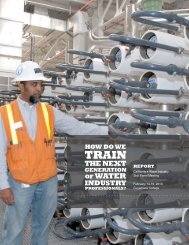Designing Switched LAN Internetworks
Designing Switched LAN Internetworks
Designing Switched LAN Internetworks
You also want an ePaper? Increase the reach of your titles
YUMPU automatically turns print PDFs into web optimized ePapers that Google loves.
<strong>Switched</strong> Internetwork Solutions• Provide a smooth evolution path to high-performance switching solutions, such as Fast Ethernetand ATM.Segmenting shared-media <strong>LAN</strong>s divides the users into two or more separate <strong>LAN</strong> segments,reducing the number of users contending for bandwidth. <strong>LAN</strong> switching technology, which buildsupon this trend, employs microsegmentation, which further segments the <strong>LAN</strong> to fewer users andultimately to a single user with a dedicated <strong>LAN</strong> segment. Each switch port provides a dedicated,10MB Ethernet segment, or dedicated 4/16MB Token Ring segment.Segments are interconnected by internetworking devices that enable communication between <strong>LAN</strong>swhile blocking other types of traffic. Switches have the intelligence to monitor traffic and compileaddress tables, which then allows them to forward packets directly to specific ports in the <strong>LAN</strong>.Switches also usually provide nonblocking service, which allows multiple conversations (trafficbetween two ports) to occur simultaneously.Switching technology is quickly becoming the preferred solution for improving <strong>LAN</strong> traffic for thefollowing reasons:• Unlike hubs and repeaters, switches allow multiple data streams to pass simultaneously.• Switches have the capability through microsegmentation to support the increased speed andbandwidth requirements of emerging technologies.• Switches deliver dedicated bandwidth to users through high-density group switched andswitched 10BaseT or 100BaseT Ethernet, flexible 10/100 BaseT Ethernet, fiber-based FastEthernet, Fast EtherChannel, Token Ring, CDDI/FDDI, and ATM <strong>LAN</strong> Emulation (<strong>LAN</strong>E).<strong>Switched</strong> Internetwork SolutionsNetwork designers are discovering, however, that many products offered as switched internetworksolutions are inadequate. Some offer a limited number of hardware platforms with little or no systemintegration with the current infrastructure. Others require complete abandonment of all investmentsin the current network infrastructure. To be successful, a switched internetwork solution mustaccomplish the following:• Leverage strategic investments in the existing communications infrastructure while increasingavailable bandwidth.• Reduce the costs of managing network operations.• Offer options to support multimedia applications and other high-demand traffic across a varietyof platforms.• Provide scalability, traffic control, and security that is at least as good or better than that of today’srouter-based internetworks.• Provide support for embedded remote monitoring (RMON) agent.The key to achieving these benefits is to understand the role of the internetworking softwareinfrastructure within the switched internetworks. Within today’s networks, routers allow for theinterconnection of disparate <strong>LAN</strong> and WAN technologies, while also implementing security filtersand logical firewalls. It is these capabilities that have allowed current internetworks to scale globallywhile remaining stable and robust.As networks evolve toward switched internetworks, similar logical internetworking capabilities arerequired for stability and scalability. Although <strong>LAN</strong> and ATM switches provide great performanceimprovements, they also raise new internetworking challenges. <strong>Switched</strong> internetworks mustintegrate with existing <strong>LAN</strong> and WAN networks. Such services as V<strong>LAN</strong>s, which will be deployedwith switched internetworks, also have particular internetworking requirements.<strong>Designing</strong> <strong>Switched</strong> <strong>LAN</strong> <strong>Internetworks</strong> 12-3
Components of the <strong>Switched</strong> Internetworking ModelA true switched internetwork, therefore, is more than a collection of boxes. Rather, it consists of asystem of devices integrated and supported by an intelligent internetworking software infrastructure.Presently, this network intelligence is centralized within routers. However, with the advent ofswitched internetworks, the intelligence will often be dispersed throughout the network, reflectingthe decentralized nature of switching systems. The need for an internetworking infrastructure,however, will remain.Components of the <strong>Switched</strong> Internetworking ModelA switched internetwork is composed of the following three basic components:• Physical switching platforms• A common software infrastructure• Network management tools and applicationsCisco provides network designers with a complete, end-to-end solution for implementing andmanaging scalable, robust, switched internetworks.Scalable Switching PlatformsThe first component of the switched internetworking model is the physical switching platform. Thiscan be an ATM switch, a <strong>LAN</strong> switch, or a router.ATM SwitchesAlthough switched internetworks can be built with a variety of technologies, many networkdesigners will deploy ATM in order to utilize its unique characteristics. ATM provides scalablebandwidth that spans both <strong>LAN</strong>s and WANs. It also promises Quality of Service (QoS)guarantees—bandwidth on demand—that can map into and support higher-level protocolinfrastructures for emerging multimedia applications and provide a common, multiservice networkinfrastructure.ATM switches are one of the key components of ATM technology. All ATM switches, however, arenot alike. Even though all ATM switches perform cell relay, ATM switches differ markedly in thefollowing capabilities:• Variety of interfaces and services that are supported• Redundancy• Depth of ATM internetworking software• Sophistication of traffic management mechanism• Blocking and non-blocking switching fabrics• SVC and PVC supportJust as there are routers and <strong>LAN</strong> switches available at various price/performance points withdifferent levels of functionality, ATM switches can be segmented into the following four distincttypes that reflect the needs of particular applications and markets:• Workgroup ATM switches• Campus ATM switches• Enterprise ATM switches12-4Internetwork Design Guide
Components of the <strong>Switched</strong> Internetworking Modeltoday. By integrating all of these services onto a common platform and a common ATM transportinfrastructure, network designers can gain greater manageability while eliminating the need formultiple overlay networks.<strong>LAN</strong> SwitchesA <strong>LAN</strong> switch is a device that typically consists of many ports that connect <strong>LAN</strong> segments (Ethernetand Token Ring) and a high-speed port (such as 100-Mbps Ethernet, Fiber Distributed Data Interface[FDDI], or 155-Mbps ATM). The high-speed port, in turn, connects the <strong>LAN</strong> switch to other devicesin the network.A <strong>LAN</strong> switch has dedicated bandwidth per port, and each port represents a different segment. Forbest performance, network designers often assign just one host to a port, giving that host dedicatedbandwidth of 10 Mbps, as shown in Figure 12–3, or 16 Mbps for Token Ring networks.Figure 12-3Host BSample <strong>LAN</strong> switch configuration.Host AEthernetEthernetEthernetEthernetPort 2Port 3Port 4Port 1High-speed portHost CHost DPort nWhen a <strong>LAN</strong> switch first starts up and as the devices that are connected to it request services fromother devices, the switch builds a table that associates the MAC address of each local device with theport number through which that device is reachable. That way, when Host A on Port 1 needs totransmit to Host B on Port 2, the <strong>LAN</strong> switch forwards frames from Port 1 to Port 2, thus sparingother hosts on Port 3 from responding to frames destined for Host B. If Host C needs to send data toHost D at the same time that Host A sends data to Host B, it can do so because the <strong>LAN</strong> switch canforward frames from Port 3 to Port 4 at the same time it forwards frames from Port 1 to Port 2.Whenever a device connected to the <strong>LAN</strong> switch sends a packet to an address that is not in the <strong>LAN</strong>switch’s table (for example, to a device that is beyond the <strong>LAN</strong> switch), or whenever the devicesends a broadcast or multicast packet, the <strong>LAN</strong> switch sends the packet out all ports (except for theport from which the packet originated)—a technique known as flooding.Because they work like traditional “transparent” bridges, <strong>LAN</strong> switches dissolve previouslywell-defined workgroup or department boundaries. A network built and designed only with <strong>LAN</strong>switches appears as a flat network topology consisting of a single broadcast domain. Consequently,these networks are liable to suffer the problems inherent in flat (or bridged) networks—that is, theydo not scale well. Note, however, that <strong>LAN</strong> switches that support V<strong>LAN</strong>s are more scalable thantraditional bridges.Multiservice Access SwitchesBeyond private networks, ATM platforms will also be widely deployed by service providers both ascustomer premises equipment (CPE) and within public networks. Such equipment will be used tosupport multiple MAN and WAN services—for example, Frame Relay switching, <strong>LAN</strong>12-6Internetwork Design Guide
Common Software Infrastructureinterconnect, or public ATM services—on a common ATM infrastructure. Enterprise ATM switcheswill often be used in these public network applications because of their emphasis on high availabilityand redundancy, and their support of multiple interfaces.Routing PlatformsIn addition to <strong>LAN</strong> switches and ATM switches, typically network designers use routers as one ofthe components in a switched internetwork infrastructure. While <strong>LAN</strong> switches are being added towiring closets to increase bandwidth and to reduce congestion in existing shared-media hubs,high-speed backbone technologies, such as ATM switching and ATM routers are being deployed inthe backbone. Within a switched internetwork, routing platforms also allow for the interconnectionof disparate <strong>LAN</strong> and WAN technologies while also implementing broadcast filters and logicalfirewalls. In general, if you need advanced internetworking services, such as broadcast firewallingand communication between dissimilar <strong>LAN</strong>s, routers are necessary.Common Software InfrastructureThe second level of a switched internetworking model is a common software infrastructure. Thefunction of this software infrastructure is to unify the variety of physical switching platforms: <strong>LAN</strong>switches, ATM switches, and multiprotocol routers. Specifically, the software infrastructure shouldperform the following tasks:• Monitor the logical topology of the network• Logically route traffic• Manage and control sensitive traffic• Provide firewalls, gateways, filtering, and protocol translationCisco offers network designers Cisco Internetwork Operating System (Cisco IOS) switchingsoftware. This subset of the Cisco IOS software is optimized for switching and provides the unifyingelement to Cisco’s line of switching platforms in a switched internetwork. The Cisco IOS softwareis found on standalone routers, router modules for shared-media hubs, PC and workstations fileservers, multiservice WAN access switches, <strong>LAN</strong> switches, ATM switches, and ATM-capablePBXs. It provides optional levels of routing and switching across a switched internetwork in additionto new capabilities, such as V<strong>LAN</strong>s, ATM internetworking software services, multilayer switching,extensions to support new networked multimedia applications, and traffic management and analysistools.V<strong>LAN</strong>sA V<strong>LAN</strong> consists of several end systems, either hosts or network equipment (such as switches androuters), all of which are members of a single logical broadcast domain. A V<strong>LAN</strong> no longer hasphysical proximity constraints for the broadcast domain. This V<strong>LAN</strong> is supported on various piecesof network equipment (for example, <strong>LAN</strong> switches) that support V<strong>LAN</strong> trunking protocols betweenthem. Each V<strong>LAN</strong> supports a separate Spanning Tree (IEEE 802.1d).First-generation V<strong>LAN</strong>s are based on various OSI Layer 2 bridging and multiplexing mechanisms,such as IEEE 802.10, <strong>LAN</strong> Emulation (<strong>LAN</strong>E), and Inter-Switch Link (ISL), that allow theformation of multiple, disjointed, overlaid broadcast groups on a single network infrastructure.Figure 12-4 shows an example of a switched <strong>LAN</strong> network that uses V<strong>LAN</strong>s. Layer 2 of the OSIreference model provides reliable transit of data across a physical link. The data link layer isconcerned with physical addressing, network topology, line discipline, error notification, ordereddelivery frames, and flow control. The IEEE has divided this layer into two sublayers: the MACsublayer and the LLC sublayer, sometimes simply called link layer.<strong>Designing</strong> <strong>Switched</strong> <strong>LAN</strong> <strong>Internetworks</strong> 12-7
Components of the <strong>Switched</strong> Internetworking ModelFigure 12-4Typical V<strong>LAN</strong> topology.Sixth floor10 MbpsV<strong>LAN</strong> 201V<strong>LAN</strong> 10Fifth floor10 Mbps86Switch AV<strong>LAN</strong> 1010 MbpsFourth floor100 MbpsV<strong>LAN</strong> 201 2Switch BV<strong>LAN</strong> 10V<strong>LAN</strong> 20Third floor10 Mbps3100 MbpsSwitch C2/2Second floor10 Mbps100 MbpsSwitch ESwitch D100 MbpsFirst floor10 MbpsIn Figure 12-4, 10-Mbps Ethernet connects the hosts on each floor to switches A, B, C, and D.100-Mbps Fast Ethernet connects these to Switch E. V<strong>LAN</strong> 10 consists of those hosts on Ports 6 and8 of Switch A and Port 2 on Switch B. V<strong>LAN</strong> 20 consists of those hosts that are on Port 1 ofSwitch A and Ports 1 and 3 of Switch B.V<strong>LAN</strong>s can be used to group a set of related users, regardless of their physical connectivity. Theycan be located across a campus environment or even across geographically dispersed locations. Theusers might be assigned to a V<strong>LAN</strong> because they belong to the same department or functional team,or because data flow patterns among them is such that it makes sense to group them together. Note,however, that without a router, hosts in one V<strong>LAN</strong> cannot communicate with hosts in anotherV<strong>LAN</strong>.Network Management Tools and ApplicationsThe third and last component of a switched internetworking model consists of network managementtools and applications. As switching is integrated throughout the network, network managementbecomes crucial at both the workgroup and backbone levels. Managing a switch-based networkrequires a radically different approach than managing traditional hub and router-based <strong>LAN</strong>s.12-8Internetwork Design Guide
Cisco <strong>Switched</strong> Internetworking ProductsAs part of designing a switched internetwork, network designers must ensure that their design takesinto account network management applications needed to monitor, configure, plan, and analyzeswitched internetwork devices and services. Cisco offers such tools for emerging switchedinternetworks.Cisco <strong>Switched</strong> Internetworking ProductsCisco offers the following products that meet the needs of a switched internetwork, all discussed inthe following sections:• Cisco ATM Switches• Cisco <strong>LAN</strong> Switches• Cisco Routing PlatformsCisco ATM SwitchesCisco’s LightStream 1010 family of ATM switches is specifically designed for workgroup andcampus backbone deployment. It incorporates support for the latest ATM Forum specifications andbuilds upon the Cisco IOS software. The LightStream 1010 is a five-slot, modular switch thatfeatures the option of dual, load-sharing, hot-swappable power supplies, 5-Gbps of shared memory,nonblocking switch fabric, and 65,536 cells of shared ATM cell buffers. It supports a wide range ofmodular, hot-swappable, desktop, backbone, and wide-area ATM interfaces. These characteristicsallow network managers to deploy it in a variety of scenarios ranging from high-density, 155-Mbpscopper UTP-5 workgroups to high-performance OC-12 backbones.In order to support the bursty, best-effort traffic generated by <strong>LAN</strong> switches and routes, theLightStream 1010 provides advanced traffic management mechanisms. The LightStream 1010’sintelligent early packet discard mechanism allows it to discard entire packets rather than individualcells when necessary, which greatly increases performance for current protocols, such as TCP/IP andIPX. It also supports the latest ATM Forum Available Bit Rate (ABR) congestion controlspecifications, which allows the LightStream 1010 to slow traffic sources before congestion becomesexcessive. Because of its support for the ATM Forum private network-network interface (PNNI)protocols, networks of LightStream 1010s can scale to hundreds of nodes.In addition, the LightStream 1010 offers a high degree of manageability. Advanced port snoopingand connection-steering capabilities allow the connections on any port to be directed to a monitorport for analysis by an external ATM analyzer. This capability is critical for the monitoring andtroubleshooting of ATM switching systems, which unlike shared-media <strong>LAN</strong>s, cannot be monitoredeasily with external devices. Simple Network Management Protocol (SNMP) monitoring andconfiguration invoked through the CiscoView graphical user interface (GUI) device configurationapplications and the AtmDirector CiscoWorks ATM system management application, allow forcomprehensive network management.By building on the Cisco IOS software, the LightStream 1010 switch also shares the advancedserviceability capabilities found today on Cisco’s multiprotocol routers. As with all Cisco routers,the LightStream 1010 switch supports such protocols as BOOTP, DHCP, Telnet, and Trivial FileTransfer Protocol (TFTP) for remote access and autoconfiguration. It also offers the accessprotections of the Cisco IOS software, from multiple password levels to TACACS for remote accessvalidation, to preclude unauthorized changes to the switch configuration. These capabilities areclearly essential to safeguard the operation of the mission-critical campus backbones in which theLightStream 1010 will typically be deployed.<strong>Designing</strong> <strong>Switched</strong> <strong>LAN</strong> <strong>Internetworks</strong> 12-9
Cisco <strong>Switched</strong> Internetworking ProductsThe Cisco/StrataCom BPX/AXIS is a powerful broadband 9.6-Gbps ATM switch designed to meetthe demanding, high-traffic needs of a large private enterprise or public service provider. TheCisco/StrataCom IGX is a 1.2-Gbps ATM-based enterprise WAN switch that can be used to provideenterprise WAN features in your internetwork. For more information on these enterprise ATMswitches, see Chapter 8, “<strong>Designing</strong> ATM <strong>Internetworks</strong>.”Cisco <strong>LAN</strong> SwitchesCisco’s Catalyst family is a comprehensive line of high-performance switches designed to helpnetwork managers easily migrate from traditional shared <strong>LAN</strong>s to fully switched internetworks. TheCatalyst family delivers the varying levels of flexibility and cost-effectiveness required for today’sdesktop, workgroup, and backbone applications while enabling enterprise-wide switchedinternetworks. Using these <strong>LAN</strong> switches instead of traditional shared hubs increase performanceand provides new capabilities, such as V<strong>LAN</strong>s.Figure 12–5 shows an example of switches that can be used in a campus backbone. In this example,the Cisco switches are used to interconnect the four buildings that comprise the campus network.Figure 12-5<strong>LAN</strong> switches in a campus backbone.Building 1Building 3Catalyst5000Catalyst5000Building 2 Building 4Catalyst5000Catalyst5000Table 12–1 summarizes the <strong>LAN</strong> switches that Cisco offers.12-10Internetwork Design Guide
Cisco <strong>LAN</strong> SwitchesTable 12-1List of Cisco <strong>LAN</strong> SwitchesCisco <strong>LAN</strong> SwitchCatalyst 5500 switchingsystemRoute switch moduleCatalyst 5000 switchingsystemCatalyst 3000 stackableswitching systemCatalyst 2900 FastEthernet switchCatalyst 1800 TokenRing switchDescriptionThe Catalyst 5500 switch chassis has 13 slots. Slot 1 is for the Supervisor Engine II modelwhich provides switching, local and remote management, and dual Fast Ethernetinterfaces. Slot 2 contains an additional redundant Supervisor Engine II in case the firstmodule fails.A failure of the active Supervisor Engine II is detected by the standby module, which takescontrol of the Supervisor Engine II switching functions. If a redundant Supervisor EngineII is not required, slot 2 is available for any interface module.The Catalyst 5500 has a 3.6-Gbps media-independent switch fabric anda 5-Gbps cell-switch fabric. The backplane provides the connection between powersupplies, Supervisor Engine II, interface modules, and backbone module. The 3.6-Gbpsmedia-independent fabric supports Ethernet, Fast Ethernet, FDDI/CDDI, ATM <strong>LAN</strong>Emulation, and RSM modules. The 5-Gbps cell-based fabric supports an ATM switchprocessor (ASP) module and ATM port adapter modules (PAMS).The Cisco Catalyst 5000 series route switch module builds upon the Route SwitchProcessor (RSP) featured in Cisco’s 7500 routing platform. The route switch moduleprovides high-performance multilayer switching and routing services between switchedVirtual <strong>LAN</strong>s (V<strong>LAN</strong>s), emulated <strong>LAN</strong>s (E<strong>LAN</strong>s) within an Asynchronous TransferMode (ATM) fabric, or across mixed media via an optional Versatile Interface Processor(VIP) and port adapters.A modular switching platform that meets high performance needs, bandwidth-intensivenetworking switching applications. It offers five slots that can be populated with anycombination of 10BaseT, 10BaseFL modules, switched 10-Mbps Fast Ethernet, FDDI, orATM modules.It delivers high performance both for client and server connections as well as for backboneconnections. Its switching backplane operates at 1.2 Gbps and provides nonblockingperformance for all switched 10-Mbps Ethernet interfaces.It supports enterprise-wide V<strong>LAN</strong> communications across Ethernet, Fast Ethernet,CDDI/FDDI, and ATM connections via the following protocols: ISL for Fast Ethernetinterfaces, 802.10 for FDDI interfaces, and <strong>LAN</strong>E v1.0 for ATM.A 16-port 10BaseT switch that has two open expansion bays that can be populated with100BaseTX/FX, 10BaseFL, 10BaseT, 100VG-Any<strong>LAN</strong>, or ATM. With the Matrixmodule, up to eight Catalyst 3000 switches can be stacked together as one logicalswitching system. The Catalyst 3000 system can also be populated with the Catalyst 3011WAN router module.A fully loaded Catalyst 3000 system can support up to 192 10BaseT ports, or 12810BaseT ports with 16 high-speed ports. Supports up to 64 V<strong>LAN</strong>s within the stack. Alsosupports ISL for Fast Ethernet, and ATM <strong>LAN</strong>E.A 14-port, fixed-configuration, Fast Ethernet switch that provides media-rate Fast Ethernetswitching in backbone, server cluster, and high-performance workgroup applications. Itssoftware architecture combines superior traffic throughput, complete V<strong>LAN</strong> solutions,traffic management, and fault tolerance.A Token Ring switch that has 16 dedicated or shared ports in the base unit plus twofeature-card slots that is designed for the workgroup switching environment. Using thefour-port Token Ring unshielded twisted-pair/shielded twisted-pair (UTP/STP) featurecards, it supports eight additional Token Ring ports.<strong>Designing</strong> <strong>Switched</strong> <strong>LAN</strong> <strong>Internetworks</strong> 12-11
<strong>Switched</strong> <strong>LAN</strong> Network DesignsCisco <strong>LAN</strong> SwitchCatalyst 1900 andCatalyst 2820Ethernet switchesCatalyst 1200workgroup switchDescriptionIdeally suited to replace shared 10BaseT hubs in the wiring closet with feature-richswitched Ethernet capability to the desktop. The Catalyst 1900 Ethernet switch features 25switched Ethernet ports providing attachment to individual workstations and 10BaseThubs. It also has two 100BaseT ports for high speed connectivity to servers andbackbones.The Catalyst 2820 Ethernet switch has 25 switched Ethernet ports and two high-speedexpansion slots. Field-installable modules provide configuration, wiring, and backboneflexibility with a choice of 100BaseT, FDDI, and future ATM modules available, whichsupport Category 5 UTP or fiber-optic cabling.A multilayer switch for workgroup applications that can benefit from OSI Layer 3 as wellas Layer 2 capabilities. It offers eight 10BaseT or 10BaseFL ports and one expansion slot.The expansion slot can be populated with either one A/B CDDI interface or one A/BFDDI interface. IP routing only supports 802.10 over FDDI V<strong>LAN</strong>s. In addition tomeeting a wide range of performance needs for Ethernet and FDDI, it offers such uniquefeatures as embedded Remote Monitoring (RMON) functionality, which helps networkmanagers monitor and control the growth and changes of client-server workgroups.Cisco Routing PlatformsBoth the Cisco 7000 and Cisco 4000 family of multiprotocol routers are particularly well suited forswitched internetworking. In particular, the first native-mode ATM router interface, the ATMInterface Processor (AIP) for the Cisco 7000 family of routers, is a key enabler for integratingexisting <strong>LAN</strong> and WAN networks with evolving, ATM-based switched internetworks.The sophisticated ATM signaling and traffic management capabilities of the AIP also allows it toplay a crucial role in the deployment of new services such as V<strong>LAN</strong>s. The AIP, a key enabler for theproduction deployment of switched internetworks, allows V<strong>LAN</strong>s to internetwork either with eachother or with external networks. The Cisco 4000 family of multiprotocol routers also support suchcapabilities, thereby providing network designers with a wide choice of price/performance points forATM-capable routers.Because the Cisco 7000 and Cisco 4000 families support FDDI, Fast Ethernet, and ATM, theyprovide network designers with a full set of options for high-speed connectivity. Both router familiesalso support routing between V<strong>LAN</strong>s on all media for ease of migration.<strong>Switched</strong> <strong>LAN</strong> Network DesignsA successful switched internetworking solution must combine the benefits of both routers andswitches in every part of the network, as well as offer a flexible evolution path from shared-medianetworking to switched internetworks.In general, incorporating switches in campus network designs results in the following benefits:• High bandwidth• Quality of Service (QoS)• Low cost• Easy configurationIf you need advanced internetworking services, however, routers are necessary. Routers offer thefollowing services:• Broadcast firewalling12-12Internetwork Design Guide
Comparison of <strong>LAN</strong> Switches and Routers• Hierarchical addressing• Communication between dissimilar <strong>LAN</strong>s• Fast convergence• Policy routing• QoS routing• Security• Redundancy and load balancing• Traffic flow management• Multimedia group membershipSome of these router services will be offered by switches in the future. For example, support formultimedia often requires a protocol, such as Internet Group Management Protocol (IGMP), thatallows workstations to join a group that receives multimedia multicast packets. In the future, Ciscowill allow switches to participate in this process by using the Cisco Group Management Protocol(CGMP). One router will still be necessary, but you will not need a router in each departmentbecause CGMP switches can communicate with the router to determine whether any of theirattached users are part of a multicast group.Switching and bridging sometimes can result in nonoptimal routing of packets. This is because everypacket must go through the root bridge of the spanning tree. When routers are used, the routing ofpackets can be controlled and designed for optimal paths. Cisco now provides support for improvedrouting and redundancy in switched environments by supporting one instance of the spanning treeper V<strong>LAN</strong>.When designing switched <strong>LAN</strong> networks, you should consider the following:• Comparison of <strong>LAN</strong> Switches and Routers• Benefits of <strong>LAN</strong> Switches (Layer 2 Services)• Benefits of Routers (Layer 3 Services)• Benefits of V<strong>LAN</strong>s• V<strong>LAN</strong> Implementation• General Network Design Principles• <strong>Switched</strong> <strong>LAN</strong> Network Design PrinciplesComparison of <strong>LAN</strong> Switches and RoutersThe fundamental difference between a <strong>LAN</strong> switch and a router is that the <strong>LAN</strong> switch operates atLayer 2 of the OSI model and the router operates at Layer 3. This difference affects the way that<strong>LAN</strong> switches and routers respond to network traffic. This section compares <strong>LAN</strong> switches androuters with regard to the following network design issues:• Loops• Convergence• Broadcasts• Subnetworking• Security<strong>Designing</strong> <strong>Switched</strong> <strong>LAN</strong> <strong>Internetworks</strong> 12-13
<strong>Switched</strong> <strong>LAN</strong> Network Designs• Media DependenceNote Because routers implement Layer 2 functionality and switches are beginning to implementLayer 3 functionality, the functions of a <strong>LAN</strong> switch and a router are merging.Loops<strong>Switched</strong> <strong>LAN</strong> topologies are susceptible to loops, as shown in Figure 12–6.Figure 12-6<strong>Switched</strong> <strong>LAN</strong> topology with loops.Packet for server YData pathSwitch AClient XSwitch B<strong>LAN</strong> 1Switch CServer YIn Figure 12–6, it is possible for packets from Client X to be switched by Switch A and then forSwitch B to put the same packet back on to <strong>LAN</strong> 1. In this situation, packets loop and undergomultiple replications. To prevent looping and replication, topologies that may contain loops need torun the Spanning-Tree Protocol. The Spanning-Tree Protocol uses the spanning-tree algorithm toconstruct topologies that do not contain any loops. Because the spanning-tree algorithm placescertain connections in blocking mode, only a subset of the network topology is used for forwardingdata. In contrast, routers provide freedom from loops and make use of optimal paths.ConvergenceIn transparent switching, neighboring switches make topology decisions locally based on theexchange of Bridge Protocol Data Units (BPDUs). This method of making topology decisionsmeans that convergence on an alternative path can take an order of magnitude longer than in a routedenvironment.In a routed environment, sophisticated routing protocols, such as Open Shortest Path First (OSPF)and Enhanced Interior Gateway Routing Protocol (Enhanced IGRP), maintain concurrenttopological databases of the network and allow the network to converge quickly.Broadcasts<strong>LAN</strong> switches do not filter broadcasts, multicasts, or unknown address frames. The lack of filteringcan be a serious problem in modern distributed networks in which broadcast messages are used toresolve addresses and dynamically discover network resources such as file servers. Broadcastsoriginating from each segment are received by every computer in the switched internetwork. Mostdevices discard broadcasts because they are irrelevant, which means that large amounts of bandwidthare wasted by the transmission of broadcasts.In some cases, the circulation of broadcasts can saturate the network so that there is no bandwidthleft for application data. In this case, new network connections cannot be established, and existingconnections may be dropped (a situation known as a broadcast storm). The probability of broadcast12-14Internetwork Design Guide
Comparison of <strong>LAN</strong> Switches and Routersstorms increases as the switched internetwork grows. Routers do not forward broadcasts, and,therefore, are not subject to broadcast storms. For more information about the impact of broadcasts,see Appendix E, “Broadcasts in <strong>Switched</strong> <strong>LAN</strong> <strong>Internetworks</strong>.”SubnetworkingTransparently switched internetworks are composed of physically separate segments, but arelogically considered to be one large network (for example, one IP subnet). This behavior is inherentto the way that <strong>LAN</strong> switches work—they operate at OSI Layer 2 and have to provide connectivityto hosts as if each host were on the same cable. Layer 2 addressing assumes a flat address space withuniversally unique addresses.Routers operate at OSI Layer 3, so can formulate and adhere to a hierarchical addressing structure.Routed networks can associate a logical addressing structure to a physical infrastructure so that eachnetwork segment has, for example, a TCP/IP subnet or IPX network. Traffic flow on routed networksis inherently different from traffic flow on switched networks. Routed networks have more flexibletraffic flow because they can use the hierarchy to determine optimal paths depending on dynamicfactors such as network congestion.SecurityInformation is available to routers and switches that can be used to create more secure networks.<strong>LAN</strong> switches may use custom filters to provide access control based on destination address, sourceaddress, protocol type, packet length, and offset bits within the frame. Routers can filter on logicalnetwork addresses and provide control based on options available in Layer 3 protocols. For example,routers can permit or deny traffic based on specific TCP/IP socket information for a range of networkaddresses.Media DependenceTwo factors need to be considered with regard to mixed-media internetworks. First, the maximumtransfer unit (MTU) differs for various network media. Table 12–2 lists the maximum frame size forvarious network media.Table 12-2MTUs for Various Network MediaMedia Minimum Valid Frame Maximum Valid SizeEthernet 46 bytes 1500 bytesToken Ring 32 bytes 16 KB theoretical, 4 KB normalFast Ethernet 46 bytes 1500 bytesFDDI 32 bytes 4468 bytesATM <strong>LAN</strong>E 64 bytes 1518 bytesATM Classical IP 64 bytes 9180 bytesSerial HDLC 14 bytes No limit, 4.5 KB normalWhen <strong>LAN</strong>s of dissimilar media are switched, hosts must use the MTU that is the lowest commondenominator of all the switched <strong>LAN</strong>s that make up the internetwork. This requirement limitsthroughput and can seriously compromise performance over a relatively fast link, such as FDDI orATM. Most Layer 3 protocols can fragment and reassemble packets that are too large for a particularsubnetwork, so routed networks can accommodate different MTUs, which maximizes throughput.<strong>Designing</strong> <strong>Switched</strong> <strong>LAN</strong> <strong>Internetworks</strong> 12-15
<strong>Switched</strong> <strong>LAN</strong> Network DesignsSecond, because they operate at Layer 2, switches must use a translation function to switch betweendissimilar media. The translation function can result in serious problems such as non-canonicalversus canonical Token Ring-to-Ethernet MAC format conversion. One issue with moving data froma Token Ring to a Ethernet network is Layer 2 addressing. Token Ring devices read the Layer 2 MACaddress as most significant bit starting from left to right. Ethernet devices read the Layer 2 MACaddress as most significant bit starting from right to left.By working at Layer 3, routers are essentially independent of the properties of any physical mediaand can use a simple address resolution algorithm (such as Novell-node-address = MAC-address)ora protocol, such as the Address Resolution Protocol (ARP), to resolve differences between Layer 2and Layer 3 addresses.Benefits of <strong>LAN</strong> Switches (Layer 2 Services)An individual Layer 2 switch might offer some or all of the following benefits:• Bandwidth—<strong>LAN</strong> switches provide excellent performance for individual users by allocatingdedicated bandwidth to each switch port (for example, each network segment). This technique isknown as microsegmenting.• V<strong>LAN</strong>s—<strong>LAN</strong> switches can group individual ports into logical switched workgroups calledV<strong>LAN</strong>s, thereby restricting the broadcast domain to designated V<strong>LAN</strong> member ports. V<strong>LAN</strong>sare also known as switched domains and autonomous switching domains. Communicationbetween V<strong>LAN</strong>s requires a router.• Automated packet recognition and translation—Cisco’s unique Automatic Packet Recognitionand Translation (APaRT) technology recognizes and converts a variety of Ethernet protocolformats into industry-standard CDDI/FDDI formats. With no changes needed in either client orserver end stations the Catalyst solution can provide an easy migration to 100-Mbps server accesswhile preserving the user’s investment in existing shared 10Base-T <strong>LAN</strong>s.Benefits of Routers (Layer 3 Services)Because routers use Layer 3 addresses, which typically have structure, routers can use techniques(such as address summarization) to build networks that maintain performance and responsiveness asthey grow in size. By imposing structure (usually hierarchical) on a network, routers can effectivelyuse redundant paths and determine optimal routes even in a dynamically changing network. Thissection describes the router functions that are vital in switched <strong>LAN</strong> designs:• Broadcast and Multicast Control• Broadcast Segmentation• Media TransitionBroadcast and Multicast ControlRouters control broadcasts and multicasts in the following ways:• By caching the addresses of remote hosts. When a host sends a broadcast packet to obtain theaddress of a remote host that the router already knows about, the router responds on behalf of theremote host and drops the broadcast packet (sparing hosts from having to respond to it).• By caching advertised network services. When a router learns of a new network service, it cachesthe necessary information and does not forward broadcasts related to it. When a client of thatnetwork service sends a broadcast to locate that service, the router responds on behalf of thatservice and drops the broadcast packet (sparing hosts from having to respond to it). For example,12-16Internetwork Design Guide
Benefits of V<strong>LAN</strong>sNovell clients use broadcasts to find local services. In a network without a router, every serverresponds to every client broadcast by multicasting its list of services. Routers manage Novellbroadcasts by collecting services not local to the switch and sending out periodic updates thatdescribe the services offered on the entire network. Each router sends out one frame for everyseven services on the network.• By providing special protocols, such as the IGMP and Protocol Independent Multicast (PIM).These new protocols allow a multicasting application to “negotiate” with routers, switches, andclients to determine the devices that belong to a multicast group. This negotiation helps limit thescope and impact of the multicast stream on the network as a whole. For information about IPmulticasting, see Chapter 13, “<strong>Designing</strong> <strong>Internetworks</strong> for Multimedia.”Successful network designs contain a mix of appropriately scaled switching and routing. Given theeffects of broadcast radiation on CPU performance, well-managed switched <strong>LAN</strong> designs mustinclude routers for broadcast and multicast management.Broadcast SegmentationIn addition to preventing broadcasts from radiating throughout the network, routers are alsoresponsible for generating services to each <strong>LAN</strong> segment. The following are examples of servicesthat the router provides to the network for a variety of protocols:• IP—Proxy ARP and Internet Control Message Protocol (ICMP)• IPX—SAP table updates• AppleTalk—ZIP table updates• Network management—SNMP queriesIn a flat virtual network, a single router would be bombarded by myriad requests needing replies,severely taxing its processor. Therefore, the network designer needs to consider the number ofrouters that can provide reliable services to a given subset of V<strong>LAN</strong>s. Some type of hierarchicaldesign needs to be considered.Media TransitionIn the past, routers have been used to connect networks of different media types, taking care of theOSI Layer 3 address translations and fragmentation requirements. Routers continue to perform thisfunction in switched <strong>LAN</strong> designs. Most switching is done within like media (such as Ethernet,Token Ring, and FDDI switches) with some capability of connecting to another media type.However, if a requirement for a switched campus network design is to provide high-speedconnectivity between unlike media, routers play a significant part in the design.Benefits of V<strong>LAN</strong>sIn a flat, bridged network all broadcast packets generated by any node in the network are sent to andreceived by all other network nodes. The ambient level of broadcasts generated by the higher layerprotocols in the network—known as broadcast radiation—will typically restrict the total number ofnodes that the network can support. In extreme cases, the effects of broadcast radiation can be sosevere that an end station spends all of its CPU power on processing broadcasts.V<strong>LAN</strong>s have been designed to address the following problems inherent in a flat, bridged network:• Scalability issues of a flat network topology• Simplification of network management by facilitating network reconfigurations<strong>Designing</strong> <strong>Switched</strong> <strong>LAN</strong> <strong>Internetworks</strong> 12-17
<strong>Switched</strong> <strong>LAN</strong> Network DesignsV<strong>LAN</strong>s solve some of the scalability problems of large flat networks by breaking a single bridgeddomain into several smaller bridged domains, each of which is a virtual <strong>LAN</strong>. Note that each virtual<strong>LAN</strong> is itself constrained by the scalability issues described in Appendix E, “Broadcasts in <strong>Switched</strong><strong>LAN</strong> <strong>Internetworks</strong>.” It is insufficient to solve the broadcast problems inherent to a flat switchednetwork by superimposing V<strong>LAN</strong>s and reducing broadcast domains. V<strong>LAN</strong>s without routers do notscale to large campus environments. Routing is instrumental in the building of scalable V<strong>LAN</strong>s andis the only way to impose hierarchy on the switched V<strong>LAN</strong> internetwork.V<strong>LAN</strong>s offer the following features:• Broadcast control—Just as switches isolate collision domains for attached hosts and onlyforward appropriate traffic out a particular port, V<strong>LAN</strong>s refine this concept further and providecomplete isolation between V<strong>LAN</strong>s. A V<strong>LAN</strong> is a bridging domain, and all broadcast andmulticast traffic is contained within it.• Security—V<strong>LAN</strong>s provide security in two ways:— High-security users can be grouped into a V<strong>LAN</strong>, possibly on the same physical segment,and no users outside of that V<strong>LAN</strong> can communicate with them.— Because V<strong>LAN</strong>s are logical groups that behave like physically separate entities, inter-V<strong>LAN</strong> communication is achieved through a router. When inter-V<strong>LAN</strong> communicationoccurs through a router, all the security and filtering functionality that routers traditionallyprovide can be used because routers are able to look at OSI Layer 3 information. In the caseof nonroutable protocols, there can be no inter-V<strong>LAN</strong> communication. All communicationmust occur within the same V<strong>LAN</strong>.• Performance—The logical grouping of users allows, for example, an engineer making intensiveuse of a networked CAD/CAM station or testing a multicast application to be assigned to aV<strong>LAN</strong> that contains just that engineer and the servers he or she needs. The engineer’s work doesnot affect the rest of the engineering group, which results in improved performance for theengineer (by being on a dedicated <strong>LAN</strong>) and improved performance for the rest of theengineering group (whose communications are not slowed down by the engineer’s use of thenetwork).• Network management—The logical grouping of users, divorced from their physical orgeographic locations, allows easier network management. It is no longer necessary to pull cablesto move a user from one network to another. Adds, moves, and changes are achieved byconfiguring a port into the appropriate V<strong>LAN</strong>. Expensive, time-consuming recabling to extendconnectivity in a switched <strong>LAN</strong> environment is no longer necessary because networkmanagement can be used to logically assign a user from one V<strong>LAN</strong> to another.V<strong>LAN</strong> ImplementationThis section describes the different methods of creating the logical groupings (or broadcast domains)that make up various types of V<strong>LAN</strong>s. There are three ways of defining a V<strong>LAN</strong>:• By port—Each port on the switch can support only one V<strong>LAN</strong>. With port-based V<strong>LAN</strong>s, noLayer 3 address recognition takes place, so Internet Protocol (IP), Novell, and AppleTalknetworks must share the same V<strong>LAN</strong> definition. All traffic within the V<strong>LAN</strong> is switched, andtraffic between V<strong>LAN</strong>s is routed (by an external router or by a router within the switch). Thistype of V<strong>LAN</strong> is also known as a segment-based V<strong>LAN</strong>.• By protocol—V<strong>LAN</strong>s based on network addresses (that is, OSI Layer 3 addresses) candifferentiate between different protocols, allowing the definition of V<strong>LAN</strong>s to be made on aper-protocol basis. With network address-based V<strong>LAN</strong>s, it will be possible to have a differentvirtual topology for each protocol, with each topology having its own set of rules, firewalls, and12-18Internetwork Design Guide
V<strong>LAN</strong> Implementationso forth. Routing between V<strong>LAN</strong>s comes automatically, without the need for an external routeror card. Network address-based V<strong>LAN</strong>s will mean that a single port on a switch can support morethan one V<strong>LAN</strong>. This type of V<strong>LAN</strong> is also known as a virtual subnet V<strong>LAN</strong>.• By a user-defined value—This type of V<strong>LAN</strong> is typically the most flexible, allowing V<strong>LAN</strong>s tobe defined based on the value of any field in a packet. For example, V<strong>LAN</strong>s could be defined ona protocol basis or could be dependent on a particular IPX or NetBIOS service. The simplest formof this type of V<strong>LAN</strong> is to group users according to their MAC addresses.Cisco’s initial method of implementing V<strong>LAN</strong>s on routers and Catalyst switches is by port. Toefficiently operate and manage protocols, such as IP, IPX, and AppleTalk, all nodes in a V<strong>LAN</strong>should be in the same subnet or network.Cisco uses three technologies to implement V<strong>LAN</strong>s:• IEEE 802.10• Inter-Switch Link (ISL)• <strong>LAN</strong> EmulationThe three technologies are similar in that they are based on OSI Layer 2 bridge multiplexingmechanisms.Note With respect to this chapter and the discussions in it, V<strong>LAN</strong>s are differentiated by assigningeach V<strong>LAN</strong> a “color” (or V<strong>LAN</strong> ID). For example, Engineering might be the “blue” V<strong>LAN</strong>, andManufacturing might be the “green” V<strong>LAN</strong>.IEEE 802.10IEEE 802.10 defines a method for secure bridging of data across a shared metropolitan area network(MAN) backbone. Cisco has initially implemented the relevant portions of the standard to allow the“coloring” of bridged traffic across high-speed backbones (FDDI, Ethernet, Fast Ethernet, TokenRing, and serial links). There are two strategies using IEEE 802.10 to implement V<strong>LAN</strong>s, dependingon how traffic is handled through the backbone:• <strong>Switched</strong> Backbone• Routed Backbone<strong>Switched</strong> BackboneIn the switched backbone topology shown in Figure 12-7, you want to ensure that intra-V<strong>LAN</strong> trafficgoes only between Segment A and Segment D (both in V<strong>LAN</strong> 10) and Segment B and Segment C(both in V<strong>LAN</strong> 20).Figure 12-7IEEE 802.10 switched backbone implementation.Segment AV<strong>LAN</strong> 10E0SwitchFDDI 0802.10FDDI 2FDDI 1SwitchE1Segment BV<strong>LAN</strong> 20Segment CE2E3Segment DV<strong>LAN</strong> 10V<strong>LAN</strong> 20Switch<strong>Designing</strong> <strong>Switched</strong> <strong>LAN</strong> <strong>Internetworks</strong> 12-19
<strong>Switched</strong> <strong>LAN</strong> Network DesignsIn Figure 12-7, all Ethernet ports on Switches X, Y, and Z are in a V<strong>LAN</strong> and are to be V<strong>LAN</strong>interfaces. All FDDI interfaces in Switches X, Y, and Z are called V<strong>LAN</strong> trunk interfaces. To ensurethat traffic from Segment A destined for Segment D on Switch Z is forwarded onto Ethernet 3 andnot onto Ethernet 2, it is colored when it leaves Switch X. Switch Z recognizes the color and knowsthat it must forward these frames onto Ethernet 3 and not onto Ethernet 2.The coloring of traffic across the FDDI backbone is achieved by inserting a 16-byte header betweenthe source MAC address and the Link Service Access Point (LSAP) of frames leaving a switch. Thisheader contains a 4-byte V<strong>LAN</strong> ID or “color.” The receiving switch removes the header andforwards the frame to interfaces that match that V<strong>LAN</strong> color.Routed BackboneIn the routed backbone topology shown in Figure 12–8, the goal is the same as for the switchedtopology—that is, to ensure that intra-V<strong>LAN</strong> traffic goes only between Segment A and Segment D(both in V<strong>LAN</strong> 10) and Segment B and Segment C (both in V<strong>LAN</strong> 20).Figure 12-8Segment AV<strong>LAN</strong> 10IEEE 802.10 routed backbone implementation.V<strong>LAN</strong> 30RouterBridging path for“gluing” V<strong>LAN</strong> 10RoutedbackboneRouterRouter ZSwitch A1RouterRouter YV<strong>LAN</strong> 30 V<strong>LAN</strong> 30Segment CV<strong>LAN</strong> 20V<strong>LAN</strong> 20 Segment BSwitch XV<strong>LAN</strong> 10Segment DIt is important that a single V<strong>LAN</strong> use only one subnet. In Figure 12-8, V<strong>LAN</strong> 10 (subnet 10) is“split” and therefore must be “glued” together by maintaining a bridged path for it through thenetwork. For Switch X and nodes in V<strong>LAN</strong> 20 (subnet 20), traffic is switched locally if appropriate.If traffic is destined for a node in V<strong>LAN</strong> 30 (subnet 30) from a node in V<strong>LAN</strong> 20, Router Y routesit through the backbone to Router Z. If traffic from Segment D on V<strong>LAN</strong> 10 is destined for a nodein V<strong>LAN</strong> 20, Router Y routes it back out the FDDI interface.Fast EtherChannelFast Ether Channel is a trunking technology based on grouping together multiple full duplex 802.3Fast Ethernets to provide fault-tolerant high-speed links between switches, routers, and servers.Fast EtherChannels can be composed of two to four industry-standard Fast Ethernet links to provideload sharing of traffic with up to 800 Mbps of usable bandwidth. Fast EtherChannels caninterconnect <strong>LAN</strong> switches, routers, servers, and clients. Since its load balancing is integrated withthe Catalyst 5000 families <strong>LAN</strong> switch architectures, there is no performance degradation for addinglinks to a channel—high throughput and low latencies can be maintained while gaining more totalavailable bandwidth. Fast EtherChannel provides link resiliency within a channel—if links shouldfail the traffic is immediately directed to the remaining links. Finally, Fast EtherChannel is not12-20Internetwork Design Guide
V<strong>LAN</strong> Implementationdependent on any type of media—it can be used with Fast Ethernet running on existing UnshieldedTwisted Pair (UTP) wiring, or single mode and multimode fiber. Figure 12–9 shows a collapsedbackbone topology design using the Fast EtherChannel modules to provide links of 400 Mb betweenswitches in the wiring closets and the data center.Figure 12-9Collapsed backbone topology design using the Fast EtherChannel modules.Data Center400 Mb400 Mb 400 MbWiring ClosetsIEEE 802.10 Design Issues• Routers fast switch IEEE 802.10, which means that the fast-switching throughput of the platformmust be considered.• V<strong>LAN</strong>s must be consistent with the routed model. (That is, subnets cannot be split.)— If subnets must be split, they must be “glued” together by a bridged path.— Normal routed behavior needs to be maintained for end nodes to correctly achieve routingbetween V<strong>LAN</strong>s.— Networks need to be designed carefully when integrating V<strong>LAN</strong>s; the simplest choice is toavoid splitting V<strong>LAN</strong>s across a routed backbone.The difference between these two strategies is subtle. Table 12–3 compares the advantages anddisadvantages of the two strategies.Table 12-3Advantages and Disadvantages of <strong>Switched</strong> and Routed Backbones<strong>Switched</strong> BackboneRouted BackboneAdvantages Disadvantages Advantages DisadvantagesPropagates colorinformation across entirenetwork.Allows greater scalability byextending bridge domains.Backbone is runningbridging.Broadcast trafficincreases drastically onthe backbone.No bridging in backbone.Easy to integrate intoexisting internetwork.Can run native protocols inthe backbone.Color information is notpropagated across backboneand must be configuredmanually.If subnets are split, a bridgedpath has to be set upbetween switches.A V<strong>LAN</strong> interface can have only one V<strong>LAN</strong> ID, and V<strong>LAN</strong> trunk interfaces support multipleV<strong>LAN</strong>s across them.<strong>Designing</strong> <strong>Switched</strong> <strong>LAN</strong> <strong>Internetworks</strong> 12-21
<strong>Switched</strong> <strong>LAN</strong> Network DesignsInter-Switch LinkISL is a Cisco-proprietary protocol for interconnecting multiple switches and maintaining V<strong>LAN</strong>information as traffic goes between switches. This technology is similar to IEEE 802.10 in that it isa method of multiplexing bridge groups over a high-speed backbone. It is defined only on FastEthernet. The discussion of routing and switching in the backbone in the section “IEEE 802.10,”earlier in this chapter, also applies to ISL.With ISL, an Ethernet frame is encapsulated with a header that maintains V<strong>LAN</strong> IDs betweenswitches. A 30-byte header is prepended to the Ethernet frame, and it contains a two-byte V<strong>LAN</strong> ID.In Figure 12–10, Switch Y switches V<strong>LAN</strong> 20 traffic between segments A and B if appropriate.Otherwise, it encapsulates traffic with an ISL header that identifies it as traffic for V<strong>LAN</strong> 20 andsends it through the interim switch to Router X.Figure 12-10Inter-switch link design.Router X100 MbpsISLRouter100 MbpsISLV<strong>LAN</strong> 10Switch X100 Mbps ISLSwitch ZV<strong>LAN</strong> 20Segment A V<strong>LAN</strong> 20V<strong>LAN</strong> 20 Segment B10 Mbps EthernetSwitch YV<strong>LAN</strong> 10Router X routes the packet to the appropriate interface, which could be through a routed networkbeyond Router X (as in this case) out the Fast Ethernet interface to Switch Z. Switch Z receives thepacket, examines the ISL header noting that this packet is destined for V<strong>LAN</strong> 20, and switches it toall ports in V<strong>LAN</strong> 20 (if the packet is a broadcast or multicast) or the appropriate port (if the packetis a unicast).Note Routers fast switch ISL, which means that the fast-switching throughput of the platform mustbe considered.<strong>LAN</strong> Emulation<strong>LAN</strong> Emulation (<strong>LAN</strong>E) is a service that provides interoperability between ATM-basedworkstations and devices connected to existing legacy <strong>LAN</strong> technology. The ATM Forum hasdefined a standard for <strong>LAN</strong>E that provides to workstations attached via ATM the same capabilitiesthat they are used to obtaining from legacy <strong>LAN</strong>s.<strong>LAN</strong>E uses MAC encapsulation (OSI Layer 2) because this approach supports the largest numberof existing OSI Layer 3 protocols. The end result is that all devices attached to an emulated <strong>LAN</strong>appear to be on one bridged segment. In this way, AppleTalk, IPX, and other protocols should havesimilar performance characteristics as in a traditional bridged environment. In ATM <strong>LAN</strong>Eenvironments, the ATM switch handles traffic that belongs to the same emulated <strong>LAN</strong> (E<strong>LAN</strong>), androuters handle inter-E<strong>LAN</strong> traffic. For more information about <strong>LAN</strong>E, see Chapter 8, “<strong>Designing</strong>ATM <strong>Internetworks</strong>.”12-22Internetwork Design Guide
V<strong>LAN</strong> ImplementationVirtual Multihomed ServersIn traditional networks, there are usually several well-known servers, such as e-mail and corporateservers, that almost everyone in an enterprise needs to access. If these servers are located in only oneV<strong>LAN</strong>, the benefits of V<strong>LAN</strong>s will be lost because all of the different workgroups will be forced toroute to access this common information source.This problem can be solved with <strong>LAN</strong>E and virtual multihomed servers, as shown in Figure 12–11.Network interface cards (NICs) allow workstations and servers to join up to eight different V<strong>LAN</strong>s.This means that the server will appear in eight different E<strong>LAN</strong>s and that to other members of eachE<strong>LAN</strong>, the server appears to be like any other member. This capability greatly increases theperformance of the network as a whole because common information is available directly throughthe optimal Data Direct VCC and does not need to be routed. This also means that the server mustprocess all broadcast traffic in each V<strong>LAN</strong> that it belongs to, which can decrease performance.Figure 12-11Multihomed servers in an ATM network.This server appearsto be a member of eachE<strong>LAN</strong> by running a LECfor each E<strong>LAN</strong>.RouterE<strong>LAN</strong> 1RouterATM switchE<strong>LAN</strong> 3E<strong>LAN</strong> 2ATM <strong>LAN</strong>/workgroup switchesTo multihome servers in non-ATM environments, there are two possible choices:• Use servers with multiple NICs (different connections into each V<strong>LAN</strong>).• Use servers with NICs that support the V<strong>LAN</strong> trunking technology (IEEE 802.10 or ISL) usedin the backbone.Virtual Trunk ProtocolThe Catalyst 5000 switch implements Cisco’s Virtual Trunk Protocol (VTP). VTP is the industry’sfirst protocol implementation specifically designed for large V<strong>LAN</strong> deployments. VTP enhancesV<strong>LAN</strong> deployment by providing the following:• Integration of ISL, 802.10, and ATM <strong>LAN</strong>-based V<strong>LAN</strong>s• Auto-intelligence within the switches for configuring V<strong>LAN</strong>s• Configuration consistency across the network• An automapping scheme for going across mixed-media backbones<strong>Designing</strong> <strong>Switched</strong> <strong>LAN</strong> <strong>Internetworks</strong> 12-23
<strong>Switched</strong> <strong>LAN</strong> Network Designs• Accurate tracking and monitoring of V<strong>LAN</strong>s• Dynamic reporting of added V<strong>LAN</strong>s across the network• Plug-and-play setup and configuration when adding new V<strong>LAN</strong>sGeneral Network Design PrinciplesGood network design is based on many concepts that are summarized by the following keyprinciples:• Examine single points of failure carefully—There should be redundancy in the network so that asingle failure does not isolate any portion of the network. There are two aspects of redundancythat need to be considered: backup and load balancing. In the event of a failure in the network,there should be an alternative or backup path. Load balancing occurs when two or more paths toa destination exist and can be utilized depending on the network load. The level of redundancyrequired in a particular network varies from network to network.• Characterize application and protocol traffic—For example, the flow of application data willprofile client-server interaction and is crucial for efficient resource allocation, such as the numberof clients using a particular server or the number of client workstations on a segment.• Analyze bandwidth availability—For example, there should not be an order of magnitudedifference between the different layers of the hierarchical model. It is important to remember thatthe hierarchical model refers to conceptual layers that provide functionality. The actualdemarcation between layers does not have to be a physical link—it can be the backplane of aparticular device.• Build networks using a hierarchical or modular model—The hierarchy allows autonomoussegments to be internetworked together.Figure 12–12 shows a high-level view of the various aspects of a hierarchical network design. Ahierarchical network design presents three layers—core, distribution, and access—with each layerproviding different functionality.The core layer is a high-speed switching backbone and should be designed to switch packets as fastas possible. This layer of the network should not perform any packet manipulation access lists andfiltering that would slow down the switching of packets.The distribution layer of the network is the demarcation point between the access and core layersand helps to define and differentiate the core. The purpose of this layer is to provide boundarydefinition and is the place at which packet manipulation can take place. In the campus environment,the distribution layer can include several functions, such as the following:• Address or area aggregation• Departmental or workgroup access• Broadcast/multicast domain definition• V<strong>LAN</strong> routing• Any media transitions that need to occur• Security12-24Internetwork Design Guide
General Network Design PrinciplesFigure 12-12Hierarchical network design model.CoreDistributionHigh-speed switchingAccessPolicy-based connectivityLocal and remote workgroup accessIn the non-campus environment, the distribution layer can be a redistribution point between routingdomains or the demarcation between static and dynamic routing protocols. It can also be the pointat which remote sites access the corporate network. The distribution layer can be summarized as thelayer that provides policy-based connectivity.The access layer is the point at which local end users are allowed into the network. This layer mayalso use access lists or filters to further optimize the needs of a particular set of users. In the campusenvironment, access-layer functions can include the following:• Shared bandwidth• <strong>Switched</strong> bandwidth• MAC layer filtering• MicrosegmentationIn the non-campus environment, the access layer can give remote sites access to the corporatenetwork via some wide-area technology, such as Frame Relay, ISDN, or leased lines.It is sometimes mistakenly thought that the three layers (core, distribution, and access) must exist inclear and distinct physical entities, but this does not have to be the case. The layers are defined to aidsuccessful network design and to represent functionality that must exist in a network. Theinstantiation of each layer can be in distinct routers or switches, can be represented by a physicalmedia, can be combined in a single device, or can be omitted altogether. The way the layers areimplemented depends on the needs of the network being designed. Note, however, that for a networkto function optimally, hierarchy must be maintained.With respect to the hierarchical model, traditional campus <strong>LAN</strong>s have followed one of twodesigns—single router and distributed backbone—as shown in Figure 12–13.<strong>Designing</strong> <strong>Switched</strong> <strong>LAN</strong> <strong>Internetworks</strong> 12-25
<strong>Switched</strong> <strong>LAN</strong> Network DesignsFigure 12-13Traditional campus design.CoreFDDIdual ringDistributionRouterRouterRouterAccessSingle-router designDistributed backbone designIn the single-router design, the core and distribution layers are present in a single entity—the router.Core functionality is represented by the backplane of the router and distribution is represented by therouter. Access for end users is through individual- or chassis-based hubs. This design suffers fromscalability constraints because the router can be only be in one physical location, so all segments endat the same location—the router. The single router is responsible for all distribution functionality,which can cause CPU overload.The distributed backbone design uses a high-speed backbone media, typically FDDI, to spreadrouting functionality among several routers. This also allows the backbone to traverse floors, abuilding, or a campus.<strong>Switched</strong> <strong>LAN</strong> Network Design PrinciplesWhen designing switched <strong>LAN</strong> campus networks, the following factors must be considered:• Broadcast radiation—Broadcast radiation can become fatal—that is, 100 percent of host CPUcycles can be consumed by processing broadcast and multicast packets. Because of delaysinherent in carrier sense multiple access collision detect (CMSA/CD) technologies, such asEthernet, any more than a small amount of broadcast traffic will adversely affect the operation ofdevices attached to a switch. Although V<strong>LAN</strong>s reduce the effect of broadcast radiation on all<strong>LAN</strong>s, there is still a scaling issue as to how many hosts should reside on a given V<strong>LAN</strong>. A routerallows for larger network designs because a V<strong>LAN</strong> can be subsegmented depending on trafficpatterns. However, in a nonoptimal network design, a single router can be burdened with largeamounts of traffic.• Well-behaved V<strong>LAN</strong>s—A well-behaved V<strong>LAN</strong> is a V<strong>LAN</strong> in which 80 percent or more of thetraffic is local to that V<strong>LAN</strong>. In an example in which the Marketing, MIS, and Engineeringdepartments each have an individual V<strong>LAN</strong> segment, the 80 percent rule is violated when a userin the Marketing V<strong>LAN</strong> reads mail from the MIS V<strong>LAN</strong>, mounts servers from the EngineeringV<strong>LAN</strong>, and sends e-mail to members of the Engineering V<strong>LAN</strong>.• Available bandwidth to access routing functionality—Inter-V<strong>LAN</strong> traffic must be routed, so thenetwork design must allocate enough bandwidth to move inter-V<strong>LAN</strong> traffic from the source,through the device that provides routing functionality, and to the destination.• Appropriate placement of administrative boundaries—Switching has the effect of flatteningnetworks, and the deployment of switching outside of your administrative boundary canadversely affect the network within your administrative boundary.12-26Internetwork Design Guide
<strong>Switched</strong> <strong>LAN</strong> Network Design PrinciplesCampus network designs are evolving rapidly with the deployment of switching at all levels of thenetwork—from the desktop to the backbone. Three topologies have emerged as generic networkdesigns:• Scaled Switching• Large Switching/Minimal Routing• Distributed Routing/SwitchingScaled SwitchingThe scaled switching design shown in Figure 12–14 deploys switching at all levels of the networkwithout the use of routers. In this design, each layer consists of switches, with switches in the accesslayer providing 10-Mbps Ethernet or 16-Mbps Token Ring to end users.Figure 12-14Scaled switching design.CoreSwitches100 MbpsDistributionSwitchesAccess100 MbpsSwitches10-Mbps Ethernetor 16-Mbps Token RingScaled switching is a low-cost and easy-to-install solution for a small campus network. It does notrequire knowledge of address structure, is easy to manage, and allows all users to communicate withone another. However, this network comprises a single broadcast domain. If a scaled switchednetwork needs to grow beyond the broadcast domain, it can use V<strong>LAN</strong>s to create multiple broadcastdomains. Note that when V<strong>LAN</strong>s are used, end users in one V<strong>LAN</strong> cannot communicate with endusers in another V<strong>LAN</strong> unless routers are deployed.Large <strong>Switched</strong>/Minimal RoutingThe large switched/minimal routing design deploys switching at the access layer of the network,either ATM switching or <strong>LAN</strong> switching at the distribution layer of the network, and ATM/<strong>LAN</strong>switching at the core. Figure 12–15 shows an example of this network design.<strong>Designing</strong> <strong>Switched</strong> <strong>LAN</strong> <strong>Internetworks</strong> 12-27
<strong>Switched</strong> <strong>LAN</strong> Network DesignsFigure 12-15Large switched/minimal routing design.Core Switches Switches155 Mbps100 MbpsDistributionRouter155 MbpsRouterRouter100 MbpsSwitchesSwitches155 Mbps100 MbpsAccess10-Mbps Ethernetor 16-Mbps Token RingSwitchesIn the case of ATM in the distribution layer, the following key issues are relevant:• <strong>LAN</strong>E support on routers and switches.• Support for UNI 3.X signaling (including point-to-multipoint).• If redundancy is provided by a virtual PVC or SVC mesh, the mesh is a single point of failure.In the case of <strong>LAN</strong> switching in the distribution layer, the following key issues are relevant:• Support for V<strong>LAN</strong> trunking technology in each device.• The switches in the distribution layer must run the Spanning-Tree Protocol to prevent loops,which means that some connections will be blocked and load balancing cannot occur.To scale the large switched/minimal routing design, a logical hierarchy must be imposed. The logicalhierarchy consists of V<strong>LAN</strong>s and routers that enable inter-V<strong>LAN</strong> communication. In this topology,routing is used only in the distribution layer, and the access layer depends on bandwidth through thedistribution layer to gain access to high-speed switching functionality in the core layer.The large switched/minimal routing design scales well when V<strong>LAN</strong>s are designed so that themajority of resources are available in the V<strong>LAN</strong>. Therefore, if this topology can be designed so that80 percent of traffic is intra-V<strong>LAN</strong> and only 20 percent of traffic is inter-V<strong>LAN</strong>, the bandwidthneeded for inter-V<strong>LAN</strong> routing is not a concern. However, if inter-V<strong>LAN</strong> traffic is greater than20 percent, access to routing in the core becomes a scalability issue. For optimal network operation,scalable routing content is needed at the distribution layer of the network.Distributed Routing/SwitchingThe distributed routing/switching design deploys switching in the access layer, routing in thedistribution layer, and some form of high-speed switching in the core layer, as shown in Figure12–16.12-28Internetwork Design Guide
SummaryFigure 12-16Distributed routing/switching design.CoreSwitchSwitch155 Mbps100 MbpsDistributionRouter Router Router Router Router RouterAccess100 MbpsSwitches100 MbpsSwitches10-Mbps Ethernetor 16-Mbps Token RingThe distributed routing/switching design follows the classic hierarchical network model bothphysically and logically. Because it provides high bandwidth for access to routing functionality, thisdesign scales very well. This design is optimized for networks that do not have the 80/20 pattern rule.If servers are centralized, most traffic is inter-V<strong>LAN</strong>; therefore, high routing content is needed.SummaryCampus <strong>LAN</strong> designs use switches to replace traditional hubs and use an appropriate mix of routersto minimize broadcast radiation. With the appropriate pieces of software and hardware in place, andadhering to good network design, it is possible to build topologies, such as the examples describedin the section “<strong>Switched</strong> <strong>LAN</strong> Network Designs” earlier in this chapter.<strong>Designing</strong> <strong>Switched</strong> <strong>LAN</strong> <strong>Internetworks</strong> 12-29
Summary12-30Internetwork Design Guide




